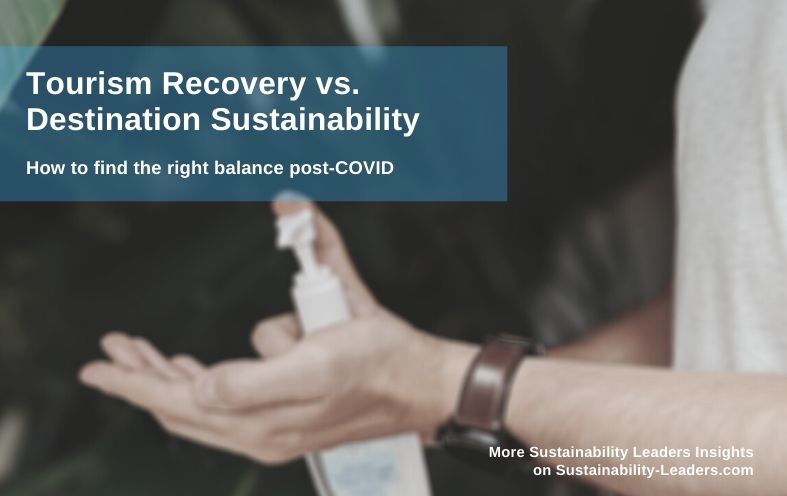
Despite all the hardships faced by humanity over the past few months, this crisis has offered us an opportunity to rethink and rebuild global tourism in a more sustainable way. So how can DMOs make the most of this pause in travel to reboot the industry?
That’s what we asked our panel of sustainable tourism specialists and below you find their answers (highlighted respondents are available to support you as consultants or speakers).
Our key takeaways:
- Reimagine and rebuild your destination with a focus on sustainability and responsible travel, using the triple bottom line approach.
- Try to encourage businesses to build resilience through following the sustainability criteria outlined by certification bodies, especially those approved by the Global Sustainable Tourism Council, or the UN Sustainable Development Goals (SDGs).
- Bring your destination’s stakeholders together to decide how much tourism they would like to permit in their community, and what it should look like, also in terms of desired outcomes.
- Collect data from travel industry players, to track the impact of tourism activity on the destination community, and to be able to streamline processes.
- Assist SMEs in their business recovery, so they can continue to offer valuable experiences to visitors and to offer employment to locals.
- Adjust your KPIs so that tourism success is measured according to ‘high-value low impact’.
Brian Mullis
Interview | Speaker profile
Destination health: Improving the destination’s capacity to provide cost-effective quality health, food safety, and environmental sanitation solutions to address the existing and future threats impacting the tourism sector.
Destination resiliency: Integrate sustainability and resilience as interwoven processes through a framework that is designed to strengthen destination management and planning, and to improve governance and resilience.
Value-based tourism strategy: As crowded destinations fall out of favour, shift from a volume-based mindset to a focus on increasing the value each traveller represents.
 Jonathon Day
Jonathon Day
Interview | Speaker profile
My advice to DMOs is to remember the ‘why’ behind why we do things. Most DMOs will say, when asked, why they do what they do – is that their role is to attract visitors.
But there is a ‘why’ behind that why. DMOs attract visitors because their role is to improve the quality of life in their community. Quality of life in a community almost always includes – a good economy, vibrant culture, and a good lifestyle, and a healthy environment (of course, if you are paying attention, you probably realise these elements align closely to the Triple Bottom Line).
So as we move to rebuild, it’s important to remember the real reasons we do what we do – and ensure our actions connect back to supporting these elements of quality of life. While ‘destination sustainability’ is a term that often lacks resonance with many DMOs – because sustainability is overused, politically charged, and/or misunderstood – improving community quality of life is something DMOs can get behind.
 Kelly Bricker
Kelly Bricker
Interview | Speaker profile
My hope and desire would be to implement sustainability practices – and as a tourism destination, I would begin with the Global Sustainable Tourism Criteria for Destinations, just revised in 2019.
Some of the uses of the criteria include the following:
- Serve as the basis for certification for sustainability
- Serve as basic guidelines for destinations that wish to become more sustainable
- Help consumers identify sound sustainable tourism destinations
- Serve as a common denominator for information media to recognise destinations and inform the public regarding their sustainability
- Help certification and other voluntary destination level programs ensure that their standards meet a broadly accepted baseline
- Offer governmental, non-governmental, and private sector programmes a starting point for developing sustainable tourism requirements
- Serve as basic guidelines for education and training bodies, such as tourism schools and universities
- Demonstrate leadership that inspires others to act.
The Criteria indicates what should be done, not how to do it, or whether the goal has been achieved. This role is fulfilled by performance indicators, associated educational materials, and access to tools for implementation, all of which are an indispensable complement to the GSTC Criteria.

Kirsi Hyvaerinen
Interview | PRÁTTO Consulting d.o.o / Speaker profile
1) Think about where you stopped and where you would like to be in 2-3, 5-10 years, and what should be your (new?) measures of success? Start or continue systematic work on being or becoming a #safe, #smart, and, a #sustainable place! With proven methods, cooperating with your neighbouring countries and here in Europe, with the ETC, intensively.
This should not be understood as a quick-fix ‘recovery project’ but as a ‘think twice and reset’ process – to change a few critical things for good. I like the way Ecotourism Australia is approaching their regions with the Build Back Better campaign.
2) Involve your businesses and local communities well ahead in time and continuously – into planning, reshaping products, services, seasonal and regional diversification – there are so many opportunities looming behind the COVID-19 cloud! Preparing and sharing all the relevant and reliable information to your stakeholders and partners in the country and abroad is very important – timely transparency is the keyword here.
3) Demand support to your SMEs – they most probably provide the majority of jobs, especially in rural areas.
 Willy Legrand
Willy Legrand
The three things to implement to kick start the destination in line with sustainability would be:
1) Hold a stakeholder meeting – Since tourism is linked to a multitude of impacts – positive and negative – on local communities and the environment, it would be of prime importance to have all actors at a destination agree on the course of action to take. This includes the tourism industry players, the destination managers and marketers, local politicians, community representatives, and environmental NGOs to name a few.
Goal: Define what the future of that destination should look like, that would equate to success (using a triple bottom line approach).
2) Involve decision makers – Using some guiding principles such as the 2030 Agenda for Sustainable Development, the Sustainable Development Goals (SDGs) and the Global Hotel Decarbonisation goal, set up a timeline indicating improvement targets together with the tourism industry players at the destinations (e.g. hotels, restaurants, parks, attractions, etc.).
Goal: Translate the desired future from Point 1 above into an actionable plan to pave the way accordingly.
3) Set up key metrics – Before starting the marketing engine of a destination, ensure that key metrics are set up to account for the triple bottom line endeavours. A particular older study commissioned by the Environmental Planning Laboratory of the European Commission on ‘Defining, Measuring and Evaluating Carrying Capacity in European Tourism Destinations’ (2002) can provide a good framework to discuss the relevant metrics.
Goal: Ensure that points 1 and 2 above are being followed through with clear benchmarks on sustainability and communicated to all stakeholders regularly.
Anna Spenceley
Interview
- Start with the GSTC Destination Criteria and design with sustainability comprehensively from the get-go.
- Consult broadly and inclusively with stakeholders in your destination, to ensure that the tourism matches their needs (but take care not to raise expectations unrealistically).
- Think about the whole life cycle of tourism – not just the start, but how your destination will evolve over time, and how to avoid overtourism if things change rapidly.
Jeremy Sampson
Interview
Some companies, and many small businesses, won’t survive a ‘lost year’ and destination managers must focus their efforts on rebuilding a diverse local supply chain that can support local economic recovery and restore and create sustainable livelihoods. This will require smart and nuanced paths to recovery, so here are three things that can be actioned now:
- Build community engagement and measures of success in your governance model. Right now is actually a really good time to do this, as many DMOs have already strengthened their connections with local businesses and residents during the lockdown and, in its absence, the benefits and drawbacks of tourism have been felt more keenly. Seeking consensus across a broader range of stakeholders will lead to a more balanced approach ‘built-in’ to destination management, and a new vision for the future.
- Build a data management system that allows you to understand the true costs and benefits of tourism and responds to a need for managed growth scenarios. Destinations often recognise they don’t have the right information at their disposal. Our experience is that if you work collaboratively across institutions, enough data exists, but it is not always being used to drive consensus-building and decision-making. With the right data, your investment decisions, promotional efforts, and management responses can be directed to bring net-positive benefits and particularly social returns.
- Understand the current state and needs of your value chain. It can be very difficult to respond to change and diversify products according to a rapidly evolving market, and this certainly cannot happen without understanding their needs. This is the time to help your supply chain adapt to new opportunities, connect with international tourism companies, and enhance their capacities.
Of course, many destination authorities will need support to build their own skills and capacities to meet current and future challenges, and it’s incumbent on everyone involved in the travel industry to facilitate this through cooperation and resources.
Marcus Cotton
Interview
- Engage with existing industries in the destination to explain, de-mystify, and give tools for sustainability at the company level.
- Create a framework/line of open communication for the industry and the DMOs to converse and work together so destination sustainability has ownership by the industry, individually and collectively.
- Reach out to the key buyers of the destination, with the local industry, to explain and promote the new sustainable image for the destination.
Masaru Takayama
Interview
- Rewrite the tourism master plan so that local satisfaction is incorporated into the decision-making process.
- Another would be compliance with the GSTC standard.
- Training for tour operators and hoteliers is as important as the other two so that they can support sustainable growth through tourism.
Shannon Guihan
Interview
I would argue that many destinations, certainly from my own backyard here in Canada, too often, don’t recognise their reliance on travel and tourism, or perhaps they do not necessarily appreciate their role in our space.
COVID-19 required a hard stop. In response, we will have a slow and staged, likely interrupted, restart. Now, more than ever, doing so in collaboration with one another will be critical. We hear these words often, though what it means to me is that we ensure cross-sector planning. It would naturally lead to a greater appreciation of the interconnected nature of the tourism sector, and by virtue of that, a greater appreciation of the need for, and effort required to become more sustainable.
Steve Noakes
Interview
1) Educate stakeholders – Find some institutional support for industry players to take this current time to complete some online training programs on sustainable tourism, for eg., the GSTC programs. This also helps to build new global networks and be exposed to alternative ways of thinking given the unique situation of shared experiences resulting from the same global challenge.
2) Make zero-emissions zones – If involved in marine tourism, make a plan to halt emissions from cruise ships as well as passenger and vehicle transfer vessels. For example, Norway halting emissions from cruise ships and ferries.
3) Decongestion strategies – Examples – stagger opening hours at popular attractions, use price incentives (such as the higher price at peak opening times), facilitate more park your own car, and shared transport options such as buses from larger car parks, etc.
More about the sustainable tourism expert panel here – including previous sessions and answers to some of the most pressing issues linked to making tourism more sustainable.
Did you enjoy our summary of expert views on how to balance tourism recovery with destination sustainability, post COVID-19? Thanks for sharing!












